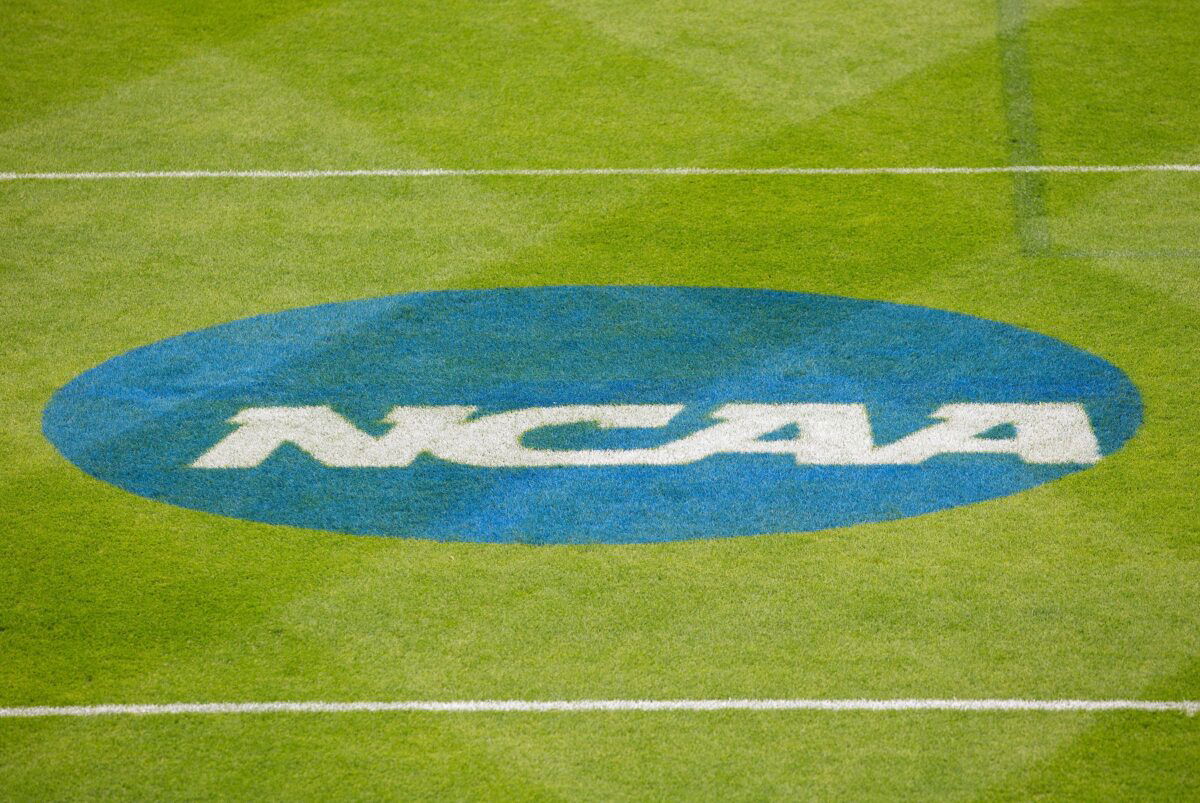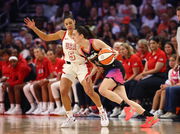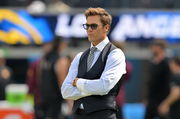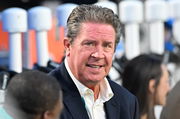
Imago
EAST HARTFORD, CT – MAY 19: General view of the NCAA, College League, USA logo prior to the Division 1 quarterfinal game between Loyola Greyhounds and Penn State Nittany Lions on May 19, 2019, at Rentschler Field in East Hartford, CT. (Photo by M. Anthony Nesmith/Icon Sportswire) NCAA LACROSSE: MAY 19 NCAA Lacrosse Championships Quarterfinals – Loyola v Penn State PUBLICATIONxINxGERxSUIxAUTxHUNxRUSxSWExNORxDENxONLY Icon19051913

Imago
EAST HARTFORD, CT – MAY 19: General view of the NCAA, College League, USA logo prior to the Division 1 quarterfinal game between Loyola Greyhounds and Penn State Nittany Lions on May 19, 2019, at Rentschler Field in East Hartford, CT. (Photo by M. Anthony Nesmith/Icon Sportswire) NCAA LACROSSE: MAY 19 NCAA Lacrosse Championships Quarterfinals – Loyola v Penn State PUBLICATIONxINxGERxSUIxAUTxHUNxRUSxSWExNORxDENxONLY Icon19051913
In today’s college football economy, where six-figure NIL (Name, Image, and Likeness) deals and brand presence rule the landscape, the ever-elusive question continues to haunt the NCAA: Are its athletes still students, or have they quietly become professionals? With direct revenue sharing now part of the NIL framework, the traditional label of “student athlete” feels increasingly out of sync. While this debate has circled for years, a prominent voice in college football has flared it up again.
Watch What’s Trending Now!
Former Penn State tight end and current national analyst Adam Breneman didn’t hold back when he publicly called out the NCAA for clinging to what he sees as an outdated and misleading term. As top players bag endorsement money and train for pro careers, Breneman argues that academics are not on anyone’s agenda. In his view, calling them “student-athletes” only masks the professional nature of what college football has become.
“The administrators, the NCAA, everyone who runs the sport refuses to call athletes what they really are, which is employees,” said Breneman in a video posted on Instagram. “They use the word student-athlete, which doesn’t make sense to begin with. None of those players are caring very much about school… they are there to play football or play men’s basketball.”
ADVERTISEMENT
The NCAA, for decades, maintained a hard line on amateurism, banning athletes from earning money through their sport. The NCAA coined the term “student-athlete” in the 1950s primarily to protect itself from workers’ compensation claims, notably after a TCU player, Kent Waldrep, suffered paralysis during a game and the NCAA denied him benefits in 1974. As per Inside NU, the NCAA crafted the phrase to maintain the illusion that athletes were primarily students. That illusion started to crack with the 2021 NIL ruling, which allowed players to profit from personal brand deals. Fast-forward to June 2025, and the House v. NCAA settlement now allows schools to directly pay athletes up to $22 million annually, without officially labeling them as employees.
“The reason all these administrators, if you talk to them off camera, they’ll acknowledge it… but they’ll never say it publicly,” Breneman explained. “Everyone is afraid to get sued. What happens if they become employees and all the athletes from the last 20 years say, ‘We were employees too, we never got paid like it. So once their employees, then you have real contracts, then you have collective bargaining just like the NFLPA (sic).” That fear isn’t unfounded, as the NIL deal also brought backpay to the tune of $2.8 billion as House settlement.
View this post on Instagram
ADVERTISEMENT
The settlement spans compensation for broadcast usage, video game likenesses, and lost sponsorship opportunities between 2016 and 2024. The NCAA has insisted that this money is antitrust compensation and not wages. Historically, the NCAA has leaned heavily on the “student-athlete” argument to avoid liability. Even Walter Byers, the NCAA executive who coined the age-old term, later admitted it was a legal shield. “The management of intercollegiate athletics stays in place committed to an outmoded code of amateurism,” he wrote in his memoir, as per The Guardian. But do fans agree with this in 2025?
Well, it’s far from unanimous, but the tides are shifting. It is reported that above 65% now believe that top-tier NCAA athletes, especially in football and basketball, function more like professionals than students. Social media trends, fan surveys, and rising NIL visibility all back this up.
ADVERTISEMENT
Should the NCAA accept a pro-level shakeup?
If the NCAA finally acknowledges athletes as professionals, expect big changes, especially in football. To begin with, athletes could gain full employment benefits such as health insurance, workers’ compensation, among others. With formal contracts and union protections, the college football world might start to resemble a mini-NFL, and powerhouse programs like Alabama or Ohio State may adapt too.
These schools already operate like pro franchises, flush with booster cash and media deals. But for smaller FBS schools, that shift could be catastrophic, as many don’t have the budget to support salaries, benefits, and legal fees tied to employee status. West Virginia is a case in point.
ADVERTISEMENT
Mountaineers reportedly lost several key players to NIL-rich rivals in the SEC last season, with their director of athletics, Wren Baker, recently stated how they simply couldn’t match the six-figure offers schools were throwing around. With the House settlement looming, some smaller programs have started cutting sports or raising ticket prices just to stay afloat. Add employment classification to that, and the gap will likely widen even more.
Top Stories
Cam Newton Makes NFL Return Conditions Clear to 32 Teams as Panthers Legend Confirms Retirement Stance

Caitlin Clark Shows Concerning Signs vs. Kelsey Plum During USA Camp Debut, per National Reporter

Tom Brady Makes Career Announcement for Vegas as Pete Carroll Addresses Losing Raiders Locker Room

“RIP”: Prayers Pour In as Tom Brady’s Raiders Struck by Tragedy

“NFL Was Crying”: Maxx Crosby Says League Forced Him to Remove Shoes Honoring His Daughter

“Rest in Peace”: Prayers Pour In From Dan Marino as Dolphins Legend Mourns Tragedy in South Florida Football

The reality is, the NIL era has permanently changed the foundation of college football. Whether athletes eventually gain recognition as employees or not, the “student-athlete” narrative continues to wear thin, and people are taking notice. The debate isn’t ending anytime soon, and with each passing ruling and settlement, the NCAA must confront a future it can’t outrun.
ADVERTISEMENT
ADVERTISEMENT
ADVERTISEMENT

